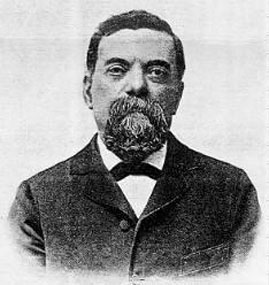| Giovanni Virginio Schiaparelli  Born: 14-Mar-1835 Born: 14-Mar-1835
Birthplace: Savigliano, Italy
Died: 4-Jul-1910
Location of death: Milan, Italy
Cause of death: unspecified
Gender: Male
Race or Ethnicity: White
Occupation: Astronomer Nationality: Italy
Executive summary: Discovered canals on Mars Italian astronomer and senator of the Kingdom of Italy, was born on the 14th of March 1835 at Savigliano in Piedmont. He entered Turin university in 1850, and graduated in 1854. Two years later he went to Berlin to study astronomy under Encke, and in 1859 was appointed assistant observer at Pulkova, a post which he resigned in 1860 for a similar one at Brera, Milan. On the death of Francesco Carlini (b. 1783) in 1862, Schiaparelli succeeded to the directorship, a position which he held until 1900. He died at Milan on the 4th of July 1910.
Schiaparelli was primarily an observer -- his first discovery was of the asteroid Hesperia in 1861 -- but he had also considerable mathematical gifts, as is shown in his treatment of orbital motions, published in 1864, and in other papers. His great contribution to astronomy dates from 1866, when he showed that meteors or shooting stars traverse space in cometary orbits, and, in particular, that the orbits of the Perseids and Comet III, 1862, and of the Leonids and Comet I, 1866, were practically the same. These discoveries, subsequently amplified in his Le Stelle cadenti (1873) and in his Norme per le osservazioni dell'estelle cadenti dei bolidi (1896) gained for him the Lalande prize of the Academy of Sciences, Paris, in 1868, and the gold medal and foreign associateship of the Royal Astronomical Society in 1872. He next worked on the double stars, but his results have only been partially published.
This labor was followed in 1877 by observations of the surface of Mars, whereon he detected, among other peculiar characters, certain streaky markings or canali, the nature and origin of which remained controversial for many decades. Mercury and Venus were also studied, and he concluded that these planets rotated on their axes in the same time as they revolved about the sun; but these views are questioned. He also discussed many other problems, such as stellar distribution, the extent of the universe, etc., while at Brera. On his retirement he turned to the astronomy of the Hebrews and Babylonians; his earlier results are given in his L'Astronomia nell' antico Testamento (1903), a work which has been translated into English and German, while later ones are to be found in various journals, the last being in Scientia (1908).
University: University of Turin (1850-54)
Royal Astronomical Society Gold Medal 1872
Bruce Medal 1902
Asteroid Namesake 4062 Schiaparelli
Martian Crater Schiaparelli
Do you know something we don't?
Submit a correction or make a comment about this profile
Copyright ©2019 Soylent Communications
|